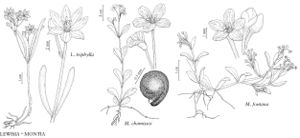Montia fontana
Sp. Pl. 1: 87. 1753.
Plants annual or biennial, never bulbiferous. Stems prostrate or decumbent, 1–30 cm, freely rooting at nodes, forming mats. Leaves opposite, sessile; blade oblanceolate to rhombic, 2–20 × 0.5–10 mm. Inflorescences leafy. Flowers 1–8, slightly bilateral; sepals 1–1.5 mm; petals 5, connate proximally, white, unequal, 1–2 mm; stamens 3, anther pink or yellow. Seeds 0.7–1.2 mm, tuberculate; elaiosome present. 2n = 20, 40.
Phenology: Flowering spring.
Habitat: Pools, springs, meadows, other wet or moist places
Elevation: 0-3700 m
Distribution

Greenland, St. Pierre and Miquelon, B.C., Man., N.B., Nfld. and Labr., N.S., Nunavut, N.W.T., Ont., P.E.I., Que., Yukon, Alaska, Calif., Idaho, Maine, Mass., Mont., Nev., N.H., N.Y., Oreg., Utah, Vt., Wash., Wyo., Central America, South America, Europe, Asia, Africa, Arctic regions
Discussion
Montia fontana displays a multitude of forms varying in stature, leaf shape, and seed size. Segregate species, varieties, and subspecies have been named. Based on my study of worldwide collections of the species, much variation in M. fontana is attributable to phenotypic differentiation of ramets produced by local environmental conditions and unrelated to genetic variation. Until macromolecular or other studies shed light on the variation in M. fontana, it seems pointless to recognize infraspecific taxa or segregate species.
